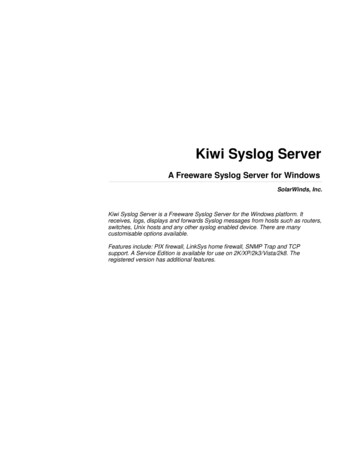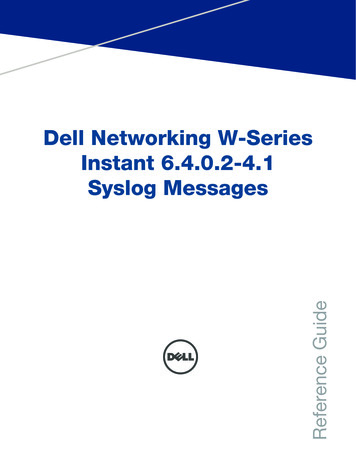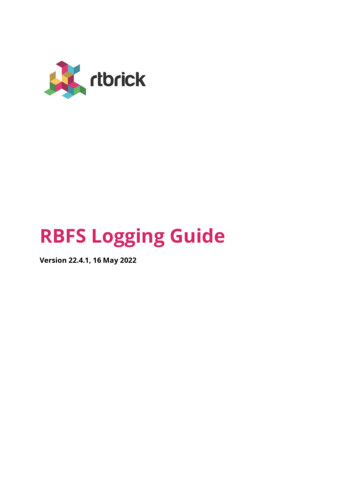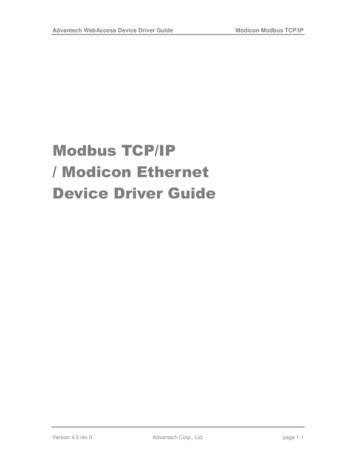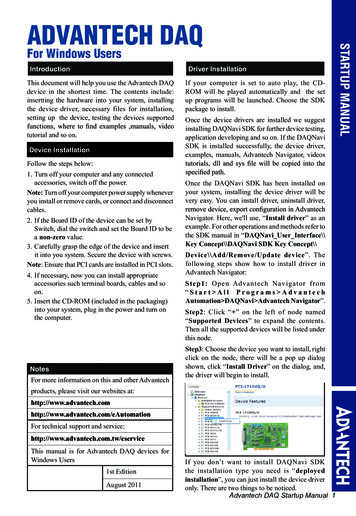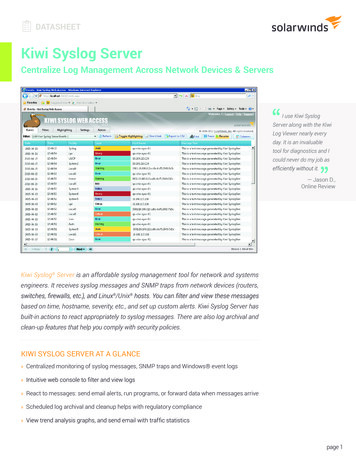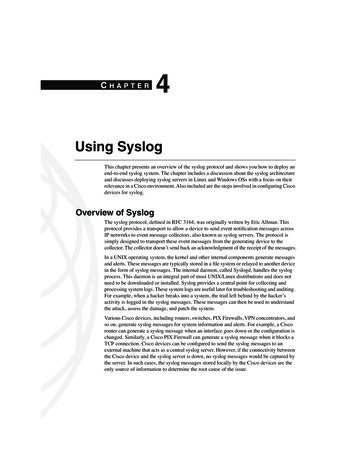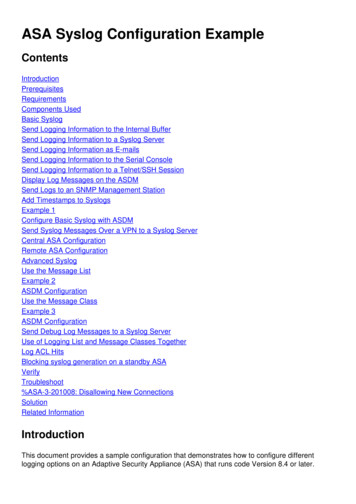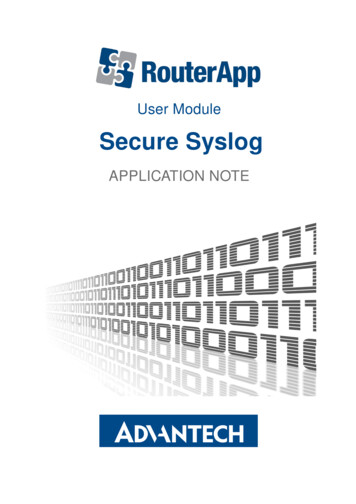
Transcription
User ModuleSecure SyslogAPPLICATION NOTE
Secure SyslogUsed symbolsDanger – Information regarding user safety or potential damage to the router.Attention – Problems that may arise in specific situations.Information or notice – Useful tips or information of special interest.Example – example of function, command or script.Advantech Czech s.r.o., Sokolska 71, 562 04 Usti nad Orlici, Czech RepublicDocument No. APP-0097-EN, revised on October 15, 2021. Released in the Czech Republic.i
Secure SyslogContents1 Introduction12 Web Interface22.1 Configuration . . . . . . . . . . . . .2.1.1 Global . . . . . . . . . . . . .2.2 Integration with local syslog service .2.3 Integration with Graylog server . . .33563 Troubleshooting74 Licenses85 Related Documents9List of Figures12345Menu . . . . . . . .Configuration . . . .Syslog configurationGraylog message . .Licenses . . . . . . .ii.23568
Secure Syslog1. IntroductionThis user module is not installed on Advantech routers by default. See ConfigurationManual for the description how to upload a user module to the router. For more information see the Configuration manual, chapter Customization – User Modules.The user module is v2, v3 and v4 router platforms compatible.As described in the Remote Monitoring Guide [6], the System Logging (syslog) protocol isused to send router event information to a specific server, such as Graglog 1 or PRTG NetworkMonitor 2 . The default syslog service provided by router firmware supports the UDP transportprotocol only, which may be used in secure private networks only.This module implements an enhanced syslog client (sender) that can forward syslog messages to a server (receiver) over a secure TLS protocol as defined in RFC 5425. Such wellauthenticated and encrypted communication may be transmitted over a public internet. Theinsecure, plain UDP and TCP transport protocols are supported too, but not aessler.com/prtg1
Secure Syslog2. Web InterfaceOnce the installation of the module is complete, the module’s GUI can be invoked byclicking the module name on the User modules page of router’s web interface.Left part of this GUI contains menu with Configuration menu section and Information menusection. Customization menu section contains only the Return item, which switches back fromthe module’s web page to the router’s web configuration pages. The main menu of module’sGUI is shown on Figure 2.Figure 1: Menu2
Secure Syslog2.12.1.1ConfigurationGlobalAll Secure Syslog user module settings can be configured by clicking on the Global itemin the main menu of module web interface. An overview of configurable items is given below.Figure 2: ConfigurationItemDescriptionEnableEnables Secure Syslog functionality.Read Kernel LogRetrieve new log messages from the /dev/kmsg. Check thisif you want to forward also kernel messages, such as information about device mounting or messages from the firewall LOG target.After service (re)start all existing kernel log entries be sentto the remote server, so the server may receive duplicatemessages. Then, the system will await new messages.Continued on the next page3
Secure SyslogContinued from previous pageItemDescriptionListen for UDPListen for syslog messages incoming via the UDP protocol.The messages can be sent by the local syslog service (seeSection 2) and/or by any remote system.After service (re)start the system immediately starts listening for new messages. Prior syslog communication will notbe distributed.Local PortUDP port where to listen for the incoming syslog messages.The common port number is 514.Remote IP AddressForward any message to this IP address.Remote PortForward to this port, e.g. 514.ProtocolForward using this protocol. Allowed values are: UDP TCP SSL/TLSAuthenticationHow to authenticate the syslog server, when using the SSL/TLS protocol. Allowed values are: None (encryption only) to skip transport receiverauthentication. The communication will still be encrypted. Certificate fingerprint to check fingerprint of the received certificate against the Acceptable Peers. Certificate validity to accept any server with a validcertificate, signed by the specified CA. Certified peer name to check certificate validity andthen match the certified DNS names in the subjectAltName extension, or the entire certified CommonName against the Acceptable Peers.Note the server may (depending on its configuration) implement own transport sender authentication, which is independent of this setting.Continued on the next page4
Secure SyslogContinued from previous pageItemDescriptionAcceptable PeersAccepted certificate fingerprint (SHA1) or DNS/CommonName of the remote peer. The DNS name may use wildcards, e.g. „*.example.net“. Required when Authenticationis set to Certificate fingerprint or Certified peer name.CA CertificatesThe entire certificate chain (sequence of CA certificates inPEM format) that can validate the remote certificates. Notrequired when Authentication is set to None.Local CertificateCertificate in PEM format. Extended key usage shall permituse for TLS client authentication!Local Private KeyThe local key and certificate don’t need to be configuredwhen the server does not enforce transport sender authentication.Table 1: Configuration items description2.2Integration with local syslog serviceTo receive syslog messages from the local syslog service, set Remote IP Address in theSyslog service configuration to 127.0.0.1, which will forward the syslog traffic to the SecureSyslog module. The Remote UDP Port shall match the Local Port discussed above.Figure 3: Syslog configuration5
Secure Syslog2.3Integration with Graylog serverFirst, install the Graylog server, either download the Open Source Edition1 or purchasethe Enterprise Edition. You may, for example, download the OVA image and then import theappliance to your virtual environment.Run the imported appliance. Once first started, the console will display a Web login andShell login information (username:password). Write down these information as they will notbe displayed again.Figure 4: Graylog messageUse these information to login to the Graylog admin. In the menu select System – Inputs,then Select input „Syslog TCP“ and click Launch new input. A configuration dialog will appear: Give the input some name. Set a Port number, e.g. 1514 (in the default configuration the number must be 1024). Enable TLS. Optionally, set a full path to a TLS cert file and private key file. Place the .crt and .key fileon the Graylog server in /etc/graylog/server/ssh . Optionally, set TLS client authentication to “optional” or “required”. When set, you haveto define also a full path to a directory with TLS Client Auth Trusted Certs. Place yourCA certificates(s) to the defined directory, e.g. /etc/graylog/server/ssh/cacerts.Once the input is created, it shall display as RUNNING and the received data shall startappearing under Streams – All Messages.Verify in the Time configuration under System – Overview that the current time (clock) ofyour routers match the clock of the Graylog server. Messages may get lost if the clockdon’t e6
3. TroubleshootingGeneric tlsv1 alert internal errors (see bellow) reported in router System Log can be causedby server-initiated session termination. Set the server log level to Debug and inspect theserver-side log for more details. Often the Local Certificate is missing or is not permitted toperform the TLS client authentication.rsyslogd: SSL\ ERROR\ SSL Error in ’osslHandshakeCheck Client’: ’error:00000001:lib(0):func(0):reason(1)(1)’ with ret 0 [v8.2010.0]rsyslogd: OpenSSL Error Stack: error:14094438:SSL routines:ssl3\ read\ bytes:tlsv1alert internal error [v8.2010.0]7
Secure Syslog4. LicensesSummarizes Open-Source Software (OSS) licenses used by this module.Figure 5: Licenses8
Secure Syslog5. Related Documents[1][2][3][4][5][6]Advantech Czech:Advantech Czech:Advantech Czech:Advantech Czech:Advantech Czech:Advantech Czech:v2 Routers Configuration Manual (MAN-0021-EN)SmartFlex Configuration Manual (MAN-0023-EN)SmartMotion Configuration Manual (MAN-0024-EN)SmartStart Configuration Manual (MAN-0022-EN)ICR-3200 Configuration Manual (MAN-0042-EN)Remote Monitoring Guide (APP-0091-EN)Product-related documents can be obtained on Engineering Portal aticr.advantech.cz address.9
when the server does not enforce transport sender authen-tication. Table 1: Configuration items description 2.2 Integration with local syslog service To receive syslog messages from the local syslog service, set Remote IP Address in the Syslog service configuration to 127.0.0.1, which will forward the syslog traffic to the Secure Syslog module.
